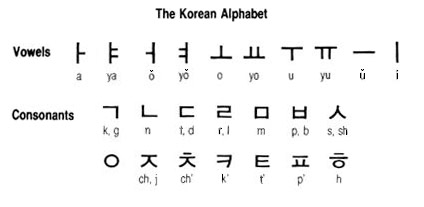(Don’t want to read my wordiness? Just use these links: Hangul Basics & Read, Write, and Pronounce Korean.)
WRITE IT. (And yes, my title is written incorrectly as a bad pun. Deal with it.) That’s the right way to learn Hangul, and eventually Korean. Unless you’re solely intent on learning to speak and comprehend spoken Korean, the proper first step for language-learning is studying the Korean script known in South Korea as Hangul or Hangeul (I prefer romanizing it as Hangeul although it is most commonly written as Hangul in English).
한글 Hangeul:
한 Han = “great”
글 Geul =”script”
Hangeul is a beautifully designed alphabet from the Joseon Dynasty (1443) that relies on grouping 24 vowel and consonant symbols into syllabic blocks. It’s read from left to right like English.
First, give yourself some background. The history of this script is interesting, and skimming the Wikipedia page is actually pretty valuable to provide a rudimentary understanding.
Secondly, use this fantastic free site for learning the individual symbols, their sounds, and how they fit together. It’s divided into six lessons, but currently only the first five are available. However, those five are sufficient to get you reading and writing Hangeul! The sixth lesson would teach you about double letters, but those are easy to recognize (they are simply smaller versions of the single letters!), ie ㄲ is the double letter for ㄱ.
EDIT: Also check out this post for some extra help.
It took me a couple days, spending twenty or so minutes each day, to learn Hangeul from this site. Don’t be lazy; dedicate one of your raggedy old unused notebooks to Hangeul and write out those words that the lessons give you. Include the romanization (the word written in English) as well as the pronunciation. Write the correct pronunciation the best way you will recognize it. You’ll feel intelligent, your notebook will suddenly seem much more valuable and interesting with all the Hangeul symbols covering its pages, and you’ll start impressing people with your Korean doodles.
If you don’t have much time or even if you do, do one or two lessons a day, as early in your day as you can. Throughout the day, take little pauses to write out a few of the symbols you learned. Read it aloud to yourself (quietly, so you don’t look as crazy), square your shoulders, and feel proud of what you’ve learned so far. Look at signs and visualize how they’d be written in Hangeul, and sound out all those fine phonetics. You might get it wrong at first, but practice, practice, practice – and then it’ll become second nature.
Don’t be intimidated; it’s one of the easiest alphabets to learn. 행운을 빌어요! ^_^

Pingback: Fail – when mistakes in Korean “bring tears to your eyes” | my {seoul} dream
Pingback: What is 기분이 and why is it 좋아? | my {seoul} dream
Pingback: Want to be my 친구? (how to say ‘friend’ in Korean) | my {seoul} dream
I’m not sure you can help me with this but I’m trying to type a word in hangul on my iPhone and it won’t work. Do you know how I can do it? It’s (ㅗ아) but the ㅇ is supposed to be under ㅗ.
감사합니다 !
LikeLike
Hi Hannah! 감사합니다 for asking 🙂 Any of these: ㅛ ㅕ ㅑ ㅐ ㅔ ㅗ ㅓ ㅏ ㅣ ㅜ ㅡ (all of the vowel or y + vowels) have to have the ㅇ first if there is not a preceding symbol. If an ㅇ comes at the end of a syllabic block, it has a “ng” sound as in “song.”
(Ps, some examples of syllabic blocks are like the 감, 사, 합, 니, and 다 syllabic blocks in 감사합니다.)
To make the syllabic block you’re trying for (I’m assuming you mean this: 왕, right?) type the symbols in this order without spaces: ㅇ ㅗ ㅏ ㅇ. 왕 is pronounced WAH-ng as if you replaced the S in song with a W.
If you meant that you want to write 옹아, just type in this order: ㅇ ㅗ ㅇ ㅇ ㅏ.
Typing in Hangeul can be very confusing at first, but with practice it becomes second nature 🙂 Good luck and have fun; I hope this helps! Did I answer your question?
LikeLike
Pingback: First Impressions: Public Transportation in Seoul | my {seoul} dream
Pingback: Common Korean Drama Phrases Part II | my {seoul} dream
Pingback: 페북 추펀: Learning Korean with Humans of Seoul | my {seoul} dream
Pingback: How To Find Korean Reading Resources For Any Level | 서울드림